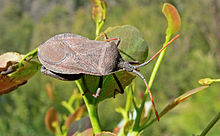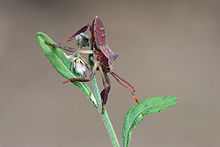- Coreidae
-
Coreidae 
Male Amorbus rubiginosus 
Coreid nymph Scientific classification Kingdom: Animalia Phylum: Arthropoda Class: Insecta Order: Hemiptera Suborder: Heteroptera Infraorder: Pentatomomorpha Superfamily: Coreoidea Family: Coreidae
Leach, 1815Subfamilies Agriopocorinae (disputed)
Coreinae
Meropachydinae
Pseudophloeinae
and see textCoreidae are a large family of predominantly herbivorous insects that belong in the hemipteran suborder Heteroptera.[1] There are more than 1,800 species in over 250 genera.[2] They vary in size from 7 to 45 mm, making the larger species some of the biggest heteropterans. The body shape of coreids is quite variable, with some species broadly oval while others are slender. Coreids are found throughout the world but most species are found in the tropics and subtropics.
In North America they are colloquially called "squash bugs", because some species, such as Anasa tristis, are pests of squash plants and other curcubits.[3][4] They are also called “leaf-footed bugs” due to the leaf-like expansions some species have on their hindlegs.
Some coreids, like Phyllomorpha laciniata, exhibit parental care by carrying their eggs. This behaviour can protect the eggs from parasitism.[5]
Contents
Taxonomy
The family Coreidae belongs to the order Hemiptera and is closely related to the families Alydidae, Hyocephalidae, Rhopalidae, and Stenocephalidae. Together, these five families form the superfamily Coreoidea.
Morphology
The general morphological features of Coreidae are an oval-shaped body, antennae composed of four segments, a numerously veined forewing membrane, a metathoracic stink gland and enlarged hind tibia.[1][3] Many species are covered with spines and tubercles.[2]
Systematics
This group is most often divided into 3-4 subfamilies; some selected genera are listed here:
Agriopocorinae Miller, 1953 (often included in Coreinae)
- Agriopocoris Miller, 1953
Coreinae Leach, 1815
- Acanthocephala Laporte, 1833
- Acanthocerus Palisot, 1818
- Althos Kirkaldy, 1904
- Amblyomia Stål, 1870
- Anasa Amyot & Serville, 1843
- Catorhintha Stål, 1859
- Chariesterus Laporte, 1833
- Chelinidea Uhler, 1863
- Chondrocera Laporte, 1832
- Cimolus Stål, 1862
- Coreus
- Dallacoris Osuna, 1981
- Euthochtha Mayr, 1865
- Ficana Stål, 1862
- Hypselonotus Hahn, 1833
- Leptoglossus Guérin-Méneville, 1831 – conifer seed bugs
- Madura Stål, 1860
- Mamurius Stål, 1862
- Mozena Amyot & Serville, 1843
- Namacus Amyot & Serville, 1843
- Narnia Stål, 1862
- Nisoscolopocerus Barber, 1928
- Phthia Stål, 1862
- Piezogaster Amyot & Serville, 1843
- Sagotylus Mayr, 1865
- Savius Stål, 1862
- Scolopocerus Uhler, 1875
- Sephina Amyot & Serville, 1843
- Sethenira Spinola, 1837
- Spartocera Laporte, 1833
- Thasus Stål, 1865
- Zicca Amyot & Serville, 1843
Meropachydinae Stål, 1867
- Merocoris Perty, 1833
Pseudophloeinae Stål, 1867
- Ceraleptus Costa, 1847
- Coriomeris Westwood, 1842
Numerous tribes of the Coreinae have previously been proposed for elevation to subfamily rank; for example the Agriopocorini, Colpurini, Hydarini, Phyllomorphini and Procamptini. But the only one of these changes accepted at least by a significant minority of researchers today is the first, and even recent reviews generally tend to treat the proposed Agriopocorinae as a tribe again, recognizing only the three subfamilies that were known by 1867. In addition, at least the genus Eubule is of decidedly indeterminate placement.
References
- ^ a b A Dictionary of Entomology. CABI Publishing. 2000.
- ^ a b True Bugs of the World (Hemiptera: Heteroptera). Classification and Natural History. Cornell University Press. 1995.
- ^ a b Baranowski, R M (1986). Coreidae of Florida (Hemiptera: Heteroptera). Florida Department of Agriculture and Consumer Services.
- ^ Hawkins, R D (2003). Shieldbugs of Surrey. Surrey Wildlife Trust.
- ^ Gomendio, M; García González, F; Reguera, P; Rivero, A (2008). "Male egg carrying in Phyllomorpha laciniata is favoured by natural not sexual selection". Animal Behaviour 75 (3): 763–770. doi:10.1016/j.anbehav.2006.12.029.
External links
- Coreidae of Britain
- Coreidae of Florida
- Comparative description of the immature stages of two very similar leaf footed bugs, Holymenia clavigera (Herbst) and Anisoscelis foliacea marginella (Dallas) (Hemiptera, Coreidae, Anisoscelini)
- Coreidae (Heteroptera: Pentatomomorpha)
- Chelinidea vittiger aequoris, a cactus bug,
- Euthochtha galeator
- Leptoglossus phyllopus
- Spartocera batatas, giant sweetpotato bug
Categories:
Wikimedia Foundation. 2010.
